




















Camshaft engine problem Brisbane - PICKED UP / SEIZED
Camshafts in older design engines such as side valve or pushrod engines are less prone to camshaft seizure or pick-up. This only appears to happen when cam bearings are fitted incorrectly. A common cause is the oil feed holes are misaligned upon cam bearing fitment. The other faulty workmanship problem exists when the bearings are fitted with not enough clearance. Camshaft must turn freely with no tight spots. Newly fitted bearings should be inspected for witness marks after a dummy fit and spin of the camshaft. Care has to be taken not to damage the bearings when fitting and removing the camshaft. Camshaft bearing journals must be measured to ensure correct size cam-bearings are used. (Also check the tunnel size and journal size as some engines have oversize backed bearings to accommodate for tunnel boring and journal grinding.) Some later model v6 pushrod engines suffer from cam seizure due to suggested miss-alignment of cam tunnel during manufacture. Oversize-backed bearings have been produced to rectify this problem. OHC ENGINES, especially those designed with alloy cylinder heads suffer more commonly from camshaft pick up or seizure. The oil feed by the nature of the design is the furthermost point from the oil pump. The oil feed hole is generally small or has a restrictor so as to control the amount of oil supplied to the over head gear. This hole is adequate when the engine is new and internally clean. As the engine sludges up the oil feed hole often becomes blocked causing oil starvation with in turn results in camshaft seizure. The breakdown in lubrication causes the alloy head cam tunnels or bearings to weld themselves to the camshaft resulting in total cam seizure. Quite often these engines suffer sever resultant damage such as bent or broken valves, piston damage, rocker arm and valve guide breakage. Some manufacturers have designed what is called a safe engine where the crankshaft and pistons can turn independently to the camshaft without contact with stationary open valves. The main causes of camshaft pick-up or seizure are lack of lubrication or severe overheating. Another common cause is the practice of surface grinding a bent OHC head without firstly physically straightening the cylinder head. The camshaft tunnels must be aligned before the head is surface ground. Several methods are used by engine reconditioners to straighten alloy heads. The head should also have a hardness test to ensure the serviceability of the head. Some alloy heads require straightening and also tunnel boring to correct the alignment. Incorrectly fitted slipper type bearing shells is a less common cause in OHC seizure but some designs allow this to take place. Most engine designers have different offset tangs on the slipper type bearings to stop the fitment of upper and lower halve shells incorrectly. When fitted incorrectly the oil feed to the camshaft is blocked causing the cam to seize in a short period. Disclaimer Agreement : Every care has been taken in writing this information and procedures, but no responsibility can be excepted for errors, omissions or misuse of this information and procedures. The information available on this site is for your instruction only and cannot be copied for sale, © copyright 2001 UMR Engines

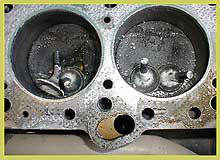

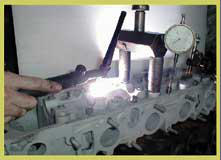

Camshaft journal picked
up in a cam tunnel
Broken valves due to
camshaft timing failure
Camshaft tunnels picked
up from camshaft seizure
Controlled straightening
of cylinder head
Re-machining top
of cylinder head




















•
Queensland Transport Authorised to approve LA1,LA3,LB1,LD1-2,LK1,LK6 Modification’s to light vehicles
•
LPG Approved Workshop
•
RWC Licence
•
RACQ Approved Automotive Repairer




Camshaft engine problem Brisbane -
PICKED UP / SEIZED
Camshafts in older design engines such as side valve or pushrod engines are less prone to camshaft seizure or pick-up. This only appears to happen when cam bearings are fitted incorrectly. A common cause is the oil feed holes are misaligned upon cam bearing fitment. The other faulty workmanship problem exists when the bearings are fitted with not enough clearance. Camshaft must turn freely with no tight spots. Newly fitted bearings should be inspected for witness marks after a dummy fit and spin of the camshaft. Care has to be taken not to damage the bearings when fitting and removing the camshaft. Camshaft bearing journals must be measured to ensure correct size cam-bearings are used. (Also check the tunnel size and journal size as some engines have oversize backed bearings to accommodate for tunnel boring and journal grinding.) Some later model v6 pushrod engines suffer from cam seizure due to suggested miss- alignment of cam tunnel during manufacture. Oversize- backed bearings have been produced to rectify this problem. OHC ENGINES, especially those designed with alloy cylinder heads suffer more commonly from camshaft pick up or seizure. The oil feed by the nature of the design is the furthermost point from the oil pump. The oil feed hole is generally small or has a restrictor so as to control the amount of oil supplied to the over head gear. This hole is adequate when the engine is new and internally clean. As the engine sludges up the oil feed hole often becomes blocked causing oil starvation with in turn results in camshaft seizure. The breakdown in lubrication causes the alloy head cam tunnels or bearings to weld themselves to the camshaft resulting in total cam seizure. Quite often these engines suffer sever resultant damage such as bent or broken valves, piston damage, rocker arm and valve guide breakage. Some manufacturers have designed what is called a safe engine where the crankshaft and pistons can turn independently to the camshaft without contact with stationary open valves. The main causes of camshaft pick- up or seizure are lack of lubrication or severe overheating. Another common cause is the practice of surface grinding a bent OHC head without firstly physically straightening the cylinder head. The camshaft tunnels must be aligned before the head is surface ground. Several methods are used by engine reconditioners to straighten alloy heads. The head should also have a hardness test to ensure the serviceability of the head. Some alloy heads require straightening and also tunnel boring to correct the alignment. Incorrectly fitted slipper type bearing shells is a less common cause in OHC seizure but some designs allow this to take place. Most engine designers have different offset tangs on the slipper type bearings to stop the fitment of upper and lower halve shells incorrectly. When fitted incorrectly the oil feed to the camshaft is blocked causing the cam to seize in a short period. Disclaimer Agreement : Every care has been taken in writing this information and procedures, but no responsibility can be excepted for errors, omissions or misuse of this information and procedures. The information available on this site is for your instruction only and cannot be copied for sale, © copyright 2001 UMR Engines
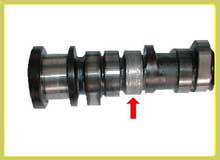
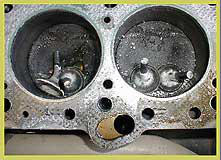


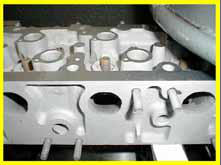
Camshaft journal picked
up in a cam tunnel
Broken valves due to
camshaft timing failure
Camshaft tunnels picked
up from camshaft seizure
Controlled straightening
of cylinder head
Re-machining top
of cylinder head




7 Moss Street, Slacks Creek, Qld 4127

































